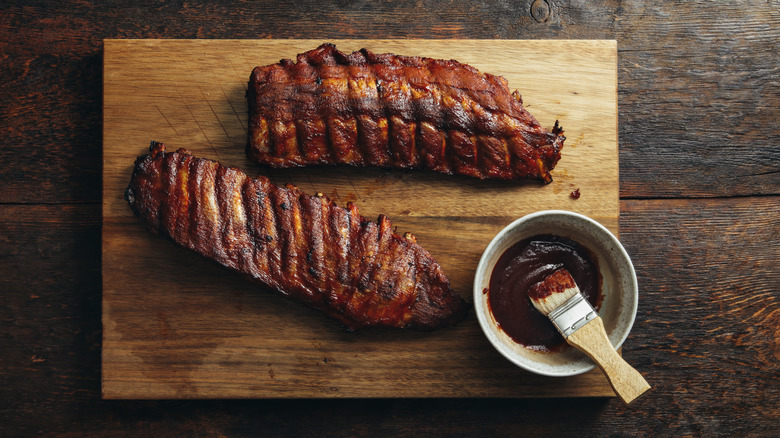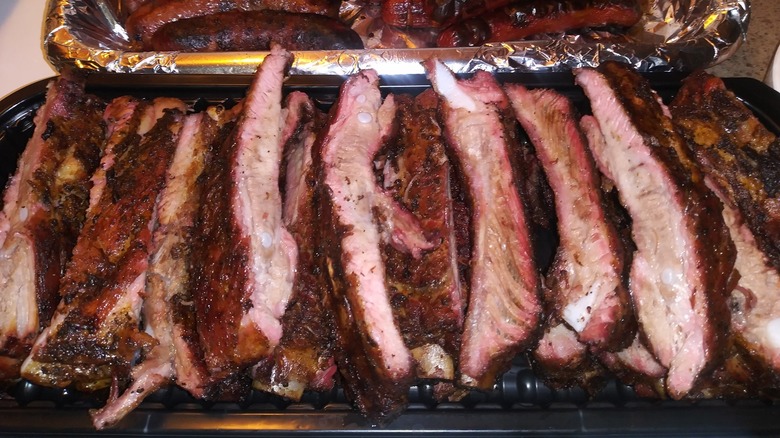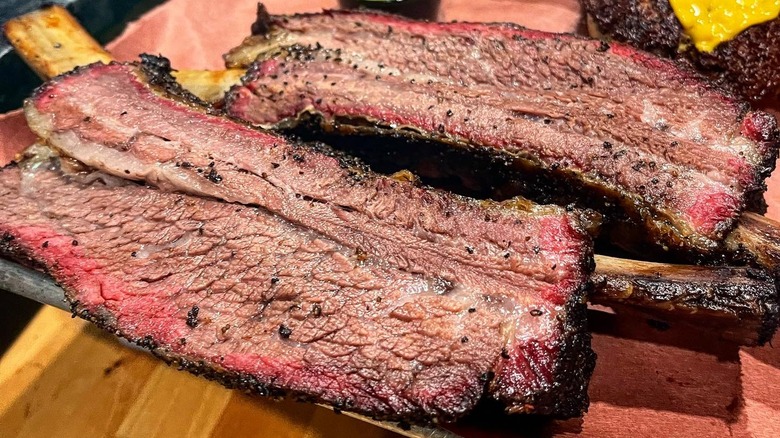The Differences That Set Baby Back And Spare Ribs Apart
When it's time to barbecue, there are a lot of options to choose from, but nothing satisfies that deeply carnivorous craving quite like gnawing the meat off of a perfectly charred and sauced rib. But when you head to the store to select your ribs for grilling, you might be met with some confusion, because you'll be able to choose between baby back ribs and spare ribs (and occasionally, even more than that). So what's the difference between these two popular types of ribs?
Well first, what they have in common is that they're both pork ribs, not beef. But these two types of ribs come from different parts of the rib cage of the hog, leading to differences in texture, flavor, and size. Baby back ribs are smaller than spare ribs and come from the top part of the rib cage that's attached to the backbone. They tend to be about 3–6 inches long, getting smaller as you go down the rack. Spare ribs, on the other hand, are cut from the bottom of the rib cage, along the breastbone. They're longer than baby back ribs, and they tend not to have the same curvature that baby back ribs have. That's the simplest explanation of the difference between spare ribs and baby back ribs, but because they're cut from different locations, that means their meat tastes and cooks up differently, too.
Flavor, tenderness, and cooking
Think of baby back ribs as the filet mignon of pork ribs. They are prized for their tender, lean meat, which tends to be on top of the bone, but as with filet, they can be a little lacking in flavor. With spare ribs, on the other hand, most of the meat is located between the bones and has more marbling. They can sometimes have smaller bones and cartilage pieces attached at the tops of the ribs, too (the rib tips). That's not ideal if you're strictly looking for ease of eating, but it's key when it comes to flavor. That marbling usually results in meat that's juicy and more flavorful, since as the meat cooks, the fat and connective tissues begin to render, keeping the meat moist and enhancing the flavor of the ribs.
Another thing to consider when deciding between baby back ribs and spare ribs is cost, and serving size. Baby back ribs tend to be pricier than spare ribs, and racks of baby back ribs usually weigh in at around 2 pounds, serving one adult. Spare ribs tend to be less expensive per pound than baby back ribs, with racks that weigh 2.5–3.5 pounds and can serve about two adults. Because racks of spare ribs are larger, and because the meat contains more fat and connective tissue, they take longer to cook, too, something to keep in mind depending on what your dinner plans are.
Other types of ribs
Baby back and spare aren't the only types of pork ribs available. You can also find St. Louis-style ribs, which are spare ribs that have been trimmed to have a more uniform shape and size, with the cartilage and bone-filled tips removed. That trim becomes rib tips, a delicacy in its own right — Chicago is known for its rib tips. You also might see country-style pork ribs in stores, sometimes with bones, sometimes without. These are usually cut from the shoulder, and occasionally the loin, and since they're not really from the ribs, some people say they're just pork chops in disguise.
Beef ribs are another matter. They're pretty big compared to any style of pork ribs, and even have the nickname "dinosaur ribs." Beef ribs, both back ribs and short ribs, have a higher fat-to-meat ratio than pork ribs and are very flavorful because of it. They tend to be more popular in cattle-producing areas of the United States, like Texas.
The next time you're planning a barbecue, or just trying to decipher the menu board at your favorite bbq joint, just remember the pork rib basics and you'll be fine. Baby back ribs are more tender, smaller, and more expensive than spare ribs; spare ribs are bigger, more flavorful, and more affordable than baby back ribs. Not sure which to go with? Get a rack of each and experiment — we have a feeling your cookout attendees won't complain!


